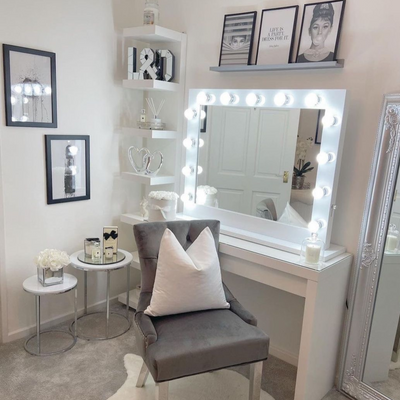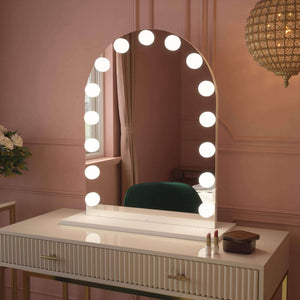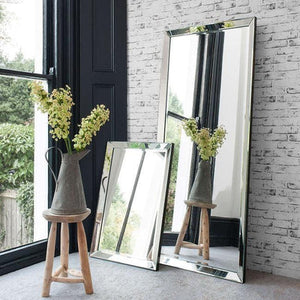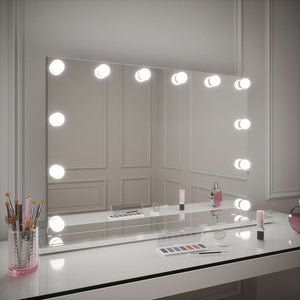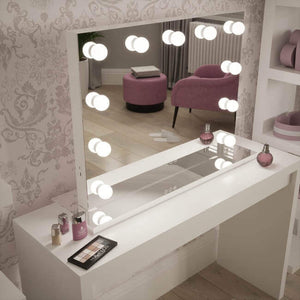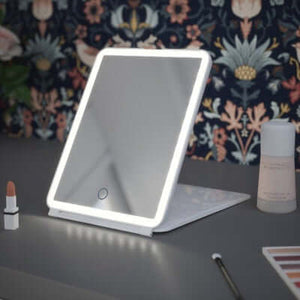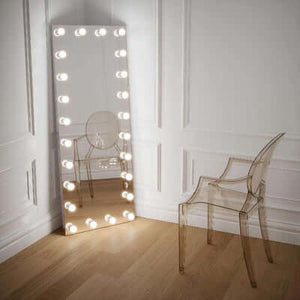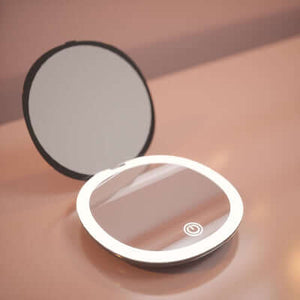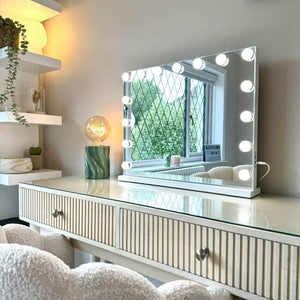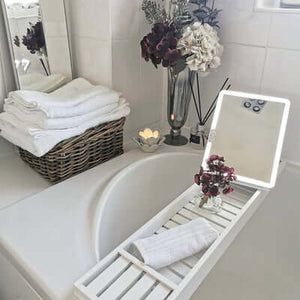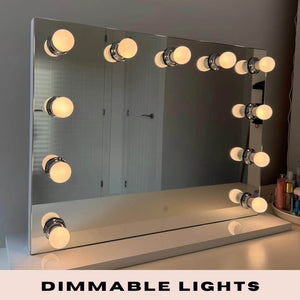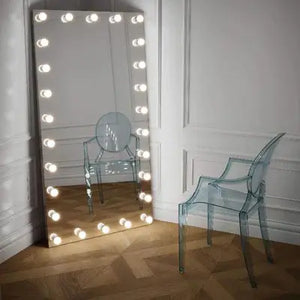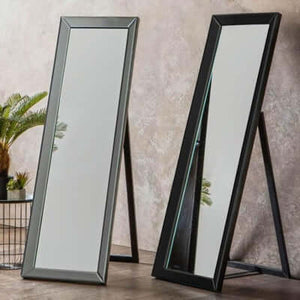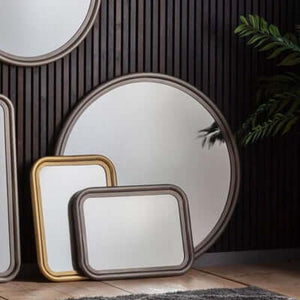The line between where we primp and where we produce has become increasingly blurred. For many, a dedicated, ergonomic home office simply isn't an option. This is where the modern vanity table steps in, proving its versatility beyond the application of makeup. More than just a station for Hollywood-style mirrors and cosmetic storage, your vanity can be transformed into a productive, confidence-boosting command centre for deep focus and study.
The Psychology of a Productive Space
The way we organise and illuminate our environment profoundly impacts our mental state and ability to focus. Our brains are constantly processing visual input; a cluttered or poorly lit space demands mental energy that should be reserved for the task at hand—whether that’s writing an essay, tackling a business report, or preparing for an exam.
The Power of Tidy Thinking
A cluttered desk doesn't just look chaotic; it is chaotic to your brain. Research from the Princeton University Neuroscience Institute suggests that a highly cluttered environment restricts your brain's ability to focus and process information efficiently. When you see stacks of products, scattered papers, or an overflow of cosmetics, your brain is subconsciously registering all of them as potential, unfinished tasks.
Creating a clutter-free zone on your vanity tabletop is the first, most critical step. This doesn't mean you have to hide everything, but it means separating your vanity's two primary functions—study and style—with clear boundaries.
-
Dedicated Storage: Utilize the vanity’s drawers and cabinets for their intended purpose: stowing everything away. For papers and study materials, a sleek, vertical file holder or a few decorative boxes can keep your tabletop clear. This sense of order creates a feeling of control, which studies show is directly linked to reduced stress and increased focus.
-
The "Study-Only" Rule: When it's time to work, only the necessary tools should be on the desk. Your laptop, notebook, and perhaps a stylish pen holder. By mentally and physically "zoning" your space this way, you train your mind to enter a state of concentration the moment you sit down.
Ergonomics: Comfort is the Foundation of Focus
The most beautiful vanity in the world won't help your studies if sitting there makes you physically uncomfortable. Ergonomics—the science of designing a workspace to fit the user—is non-negotiable for long study sessions.
Perfecting the Height and Posture
Standard vanity heights often fall between 28 and 32 inches (71 to 81 cm) from the floor to the tabletop. This range is often similar to a standard desk, but it's vital to pair it with the correct chair or stool.
The goal is to maintain a posture where:
-
Elbows are at a 90-to-110-degree angle when your hands are resting on the table. Your forearms should be parallel to the floor.
-
Feet are flat on the floor. If the vanity height is on the taller side and you need to raise your chair, you may need a footrest to keep your lower body in an ergonomic position.
-
The gap between the seat and the tabletop should ideally be between 10 to 12 inches (25 to 30 cm) to ensure you have adequate legroom and are not straining your shoulders.
If your vanity stool is non-adjustable, consider adding a supportive, firm cushion to adjust your height. Maintaining this proper posture helps prevent the neck and back pain that causes you to fidget, break concentration, and ultimately cut your study time short.
Digital Device Placement
If you're using a laptop or monitor, its positioning is crucial for neck health and eye strain. The top of your screen should be at or slightly below eye level. This prevents you from hunching over or craning your neck upward. A simple stack of books or a dedicated monitor stand can lift a laptop to the correct viewing height. When you're facing a challenging assignment, whether it's a deep dive into philosophy or an urgent report where you wish you could just do my assignment and move on, having your digital workspace correctly set up means one less battle for your body to fight.
Harnessing the Power of Light
As a vanity owner, you already have an advantage: excellent lighting. The beautiful, even illumination provided by Hollywood-style mirrors is typically designed to mimic natural daylight, which is the best light source for concentration.
Colour Temperature for Alertness
Lighting is a powerful zeitgeber, or an external cue for the body’s circadian rhythm. Different colour temperatures affect mood and focus:
-
Cool White Light (4000K to 5000K): This is the crisp, white light that feels most like daylight. Studies have shown that this cooler light temperature boosts alertness and enhances cognitive function, making it ideal for tasks requiring intense focus, like reading complex texts or solving problems. Your Hollywood-style mirror lighting, often optimised for true-to-life colour rendering, is perfectly suited for this type of focused work.
-
Warm Light (2700K to 3000K): This has a yellowish hue and is best for winding down, relaxed reading, or light creative work, as it promotes feelings of calmness.
If your mirror lights are adjustable, switch to the cooler setting for peak study hours. If they are static, you can supplement your setup with an adjustable, cool-toned LED task lamp focused directly on your books or notebook. Positioning the task lamp on the side opposite your writing hand (e.g., left side if you are right-handed) will also prevent casting annoying shadows across your work.
Maximising Natural Light
Whenever possible, try to position your vanity near a window. Exposure to natural light has been shown to significantly improve mood and productivity. It helps regulate your internal body clock, leading to better sleep and sustained alertness during the day. If glare is an issue, adjustable blinds or light curtains can diffuse the light without completely blocking it. For more detailed insights on the psychology of lighting, theRensselaer Polytechnic Institute's Lighting Research Center offers excellent resources on the impact of light on human health and performance.
Incorporating Confidence-Boosting Elements
The vanity’s unique strength is its association with self-care and confidence. Use this to your advantage by integrating elements that reinforce a positive mindset.
Strategic Decoration
While clutter is the enemy, a completely sterile environment can feel isolating. Strategically place items that inspire and motivate you:
-
A Vision Board or Goal List: Instead of a complex art piece, consider a small, elegant frame that holds your academic or professional goals. Every time you look up, you’re reminded of your ‘why.’
-
Calming Colours: Use accessories in shades of blue or green. These colours are often associated with calmness and clarity, and can help reduce stress, according to environmental psychology.
-
Personal Touches: A small plant, a scented candle (unlit during heavy study, as strong scents can be distracting), or a piece of calming artwork can transform the space from purely functional to emotionally supportive.
Music and Soundscaping
The acoustic environment is just as important as the visual one. If silence is distracting, consider using ambient sound or certain types of music. While popular music with lyrics can hijack your attention, instrumental music, nature sounds, or simple brown noise can serve as an acoustic "buffer," helping to block out household distractions and encourage deep focus. A small, discreet Bluetooth speaker can be an excellent vanity accessory for this purpose.
Maintaining the Dual-Purpose Space
Transitioning between your "beauty mode" and your "study mode" should be a quick, seamless routine.
-
The Five-Minute Tidy: Institute a rule that before you use the vanity for one purpose, you put away the items from the last purpose. Before a study session, your mirror surface should be cleared of all makeup and styling tools. After studying, papers and books go into their dedicated storage before you bring out your cosmetic bag. This habit prevents "clutter creep" and reinforces the mental switch between relaxation and rigorous work.
-
A Comfortable Seat for Both: Invest in a high-quality, ergonomic chair that is also aesthetically pleasing. Because your vanity is likely in a bedroom or dressing area, a chair that rolls and swivels might be too much, but look for a stool with a supportive backrest and comfortable padding. A chair that is comfortable enough for an hour-long study session will certainly be comfortable enough for ten minutes of self-care.
By taking a practical, research-backed approach to your vanity setup, you leverage the powerful lighting and dedicated surface you already own. You’re not just creating a place to look good; you’re creating a space that is designed to help you think good, providing the focus and confidence needed to tackle any challenge that comes your way. This intentional design turns a beautiful vanity into a brilliant, productive asset in your home.
Liquid error (sections/article-template line 192): Invalid form type "38\n", must be one of ["product", "storefront_password", "contact", "customer_login", "create_customer", "recover_customer_password", "reset_customer_password", "guest_login", "currency", "activate_customer_password", "customer_address", "new_comment", "customer", "localization", "cart"]
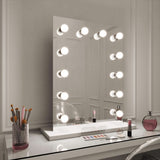 Alicia Hollywood Mirror 60cmx80cm
Alicia Hollywood Mirror 60cmx80cm Angelina Full Length Arch Hollywood Mirror 160 x 60cm
Angelina Full Length Arch Hollywood Mirror 160 x 60cm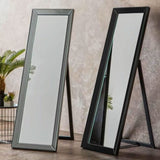 Angled Luna Mirror-Cheval Black
Angled Luna Mirror-Cheval Black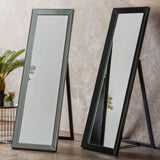 Angled Luna Mirror-Cheval Gray
Angled Luna Mirror-Cheval Gray

